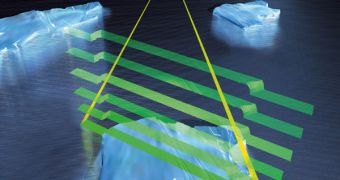The European Space Agency (ESA) is proud to announce that the advanced CryoSat ice-measuring satellite has finally begun its operational life on its orbit around the Earth, and that it's now ready to deliver top-quality weather and climate date back to mission controllers.
The event was marked by a ceremony that took place on November 19 in the Netherlands, at the European Space Research and Technology Center (ESTEC). The Cryosat operations team now has control over the satellite.
From this point forward, the spacecraft will begin controlling ice-thickness data from around the Earth. This will assist climate scientists in developing more accurate models to explain the influence of climate change and global warming on our planet.
The polar environments are the main targets that CryoSat will focus one, explains mission manager Tommaso Parrinello, who got control of the mission from CryoSat-2 project manager Richard Francis during the ceremony.
“The commissioning phase has proved what a high quality system we have in CryoSat. This is a tribute to the team. Handing over to Tommaso to begin its operational life is an important milestone and achievement,” Francis explains.
“Although tinged with sadness for me, as it marks the end of a formal involvement with this wonderful project, Tommaso inherits a superb mission and I am confident he will make the most of it,” he adds.
During the commissioning phase of the mission, the satellite itself and all of its instruments were tested in a wide array of conditions, to see whether they can function in the harshness of space.
Additionally, researchers also investigated if the data retrieval and data processing procedures that were set in place before CryoSat launched are optimized for orbital operations. Experts at ESRIN, the ESA Center of Earth Observation, in Frascati, Italy, are now in charge of the mission.
“The commissioning phase has proven that both the satellite and the ground segment are in good shape. We are now looking forward to releasing the data to the scientific community next month and equally eager to receive the first results,” explains Dr Parrinello.
“I am privileged to take over the responsibility of this important mission which will play a key role in understanding how our climate is changing,” he says.
Mission monitoring, operations and control will still be exerted from the Flight Operations Segment at the ESA European Space Operations Center (ESOC) in Darmstadt, Germany.
One of the most important things experts expect to make sense of by using CryoSat is how our planet functions as a system. This can lead to a better understanding of climate change, and may help create more accurate predictions.
The main mission Cryosat-2 has is to measure with extreme accuracy the evolution of Earth's polar caps. These measurements are of vital importance for informing policymakers in their initiatives to mitigate global warming and climate change.
The spacecraft is capable of taking centimeter-resolution readings of the ices, showing when and where it is melting, and where it's growing. It will remain airborne for around three years, and perhaps even more after that.
The satellite, which is one of the most sensitive ever launched, took off aboard a Dnepr rocket on April 8, from the Baikonur Cosmodrome, in Kazakhstan. The Russian-Ukrainian delivery system roared into space at 15:57 CEST (13:57 UTC), inserting Cryosat-2 into a 447-mile (720-kilometer) near-polar orbit.

 14 DAY TRIAL //
14 DAY TRIAL //